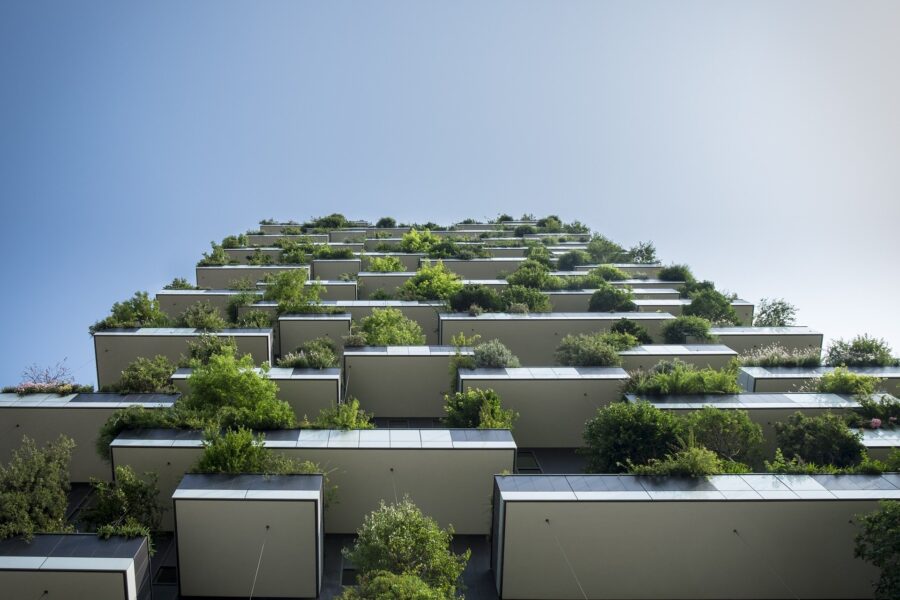*This article originally appeared in the January 2022 edition of Le Circuit, the quarterly online publication of the Ordre des traducteurs, terminologues et interprètes agréés du Québec.
In 2020, the Canada Green Building Council reported that Canada’s green building sector could contribute 1.5 million jobs and $150 billion in Gross Domestic Product by 2030, in addition to helping Canada meet its climate change targets. The growing number of buildings that are certified “green” in their design, construction or operation, is therefore proving to be a significant contributor in reducing the overall impact of the built environment on human health and the natural environment. Along with sector growth, however, comes an ever-increasing number of certification programs to address developments in the green building industry. For translators, knowing the terminology used in each certification program becomes critical in helping end-clients achieve environmental certification for their buildings or construction products.
A brief history of green building in North America
While green building is a relatively new field, it is not a new concept. Some green building practices date back thousands of years, such as using local and renewable materials or passive solar design. As a case in point, the Ancestral Puebloans were an ancient Native American culture that inhabited the southwestern region of the United States and built entire villages so that all the homes retained solar heat in the winter. Similarly, the Aztecs of Mexico used adobe bricks to build energy-efficient homes that offered naturally cool spaces on hot days due to the walls’ greater thermal mass. The green building movement as we know it today, however, began to take shape in the 1970s as a result of the OPEC oil embargo in 1973, leading to growing concerns about the Western world’s reliance on fossil fuels.
Green building certifications and rating systems
Currently, the most well-known green building certification in North America is the Leadership in Energy and Environmental Design (LEED) program. Established in 1994 by the U.S. Natural Resources Defense Council and run by the U.S. Green Building Council (USGBC), by 2015, LEED had grown from one standard for new constructions to a comprehensive system of interrelated standards covering everything from building design and construction to maintenance and operations. In 2003, the Canada Green Building Council (CaGBC) became the Canadian license holder for the LEED green building rating system.
Over the years, numerous other programs and certifications have been established in North America which translators and terminologists can refer to in order to inform their practice, including:
- BOMA Best Sustainable Buildings certification for existing commercial buildings
- Living Building Challenge, requiring net-zero energy, waste, and water by every project
- Novoclimat, in Québec, for the construction of new, high-performing homes
- Passive House, for energy-efficient buildings designed to harness and retain heat from the sun
- Green Key for hotels and lodging facilities committed to improving their environmental and cost performance
- Zero Carbon Building Standard, helping buildings achieve zero carbon in design and in annual operations
- Cradle to Cradle for building materials, interior design products, textiles and fabrics, paper and packaging, and personal and homecare products
- Environmental Product Declarations to communicate transparent and comparable information about the life-cycle environmental impact of products
- Health Product Declarations to provide a full disclosure of the potential chemicals of concern in products
- And more
Environmental certifications and what they tell consumers
While the purpose of environmental certifications is to give building owners and operators the tools they need to immediately and measurably improve their buildings’ energy performance, their general benefits can be grouped into three categories: environmental, economic, and social. From an environmental perspective, they maximize the use of energy, water, and other resources in all stages of a building’s life cycle. Economically, they create cost savings on utility bills for tenants or households, lower construction costs, increase property value, and make businesses more profitable. At the social level, environmental certifications promote the health and well-being of people who work in green offices or live in green homes.
Translation issues in the certification process
The proliferation of green building certification programs means that building owners and operators have a range of options available to them to mitigate the impact of their buildings on the natural environment. However, it also means that each green product standard has its own approach, definitions and measurements, and that the reports produced may not be comparable.
This is complicated by the fact that the most respected green building certifications require an independent third party external to the product manufacturer, contractor, designer and specifier, that is responsible for conducting the product testing and awarding the certification. While third-party auditors may hold their own accreditations and have knowledge of the terminology applicable to a specific certification (such as those granted by LEED) in order to verify conformity with the program requirements, there are a number of aspects that can differ from one auditor to another in the reports they produce to submit to the recipient organizations.
To demonstrate this, let’s take the example of an Environmental Product Declaration (EPD). According to Vertima, a green building and materials experts firm based in Quebec, in order for the EPDs for different products to be comparable, the EPDs must:
- Concern products that perform the same function
- Use the same functional unit (quantity of a product for use as a reference unit)
- Be based on the same product category rules and version
- Follow the same life cycle impact method and version
- Be modelled identically with respect to the data used and system boundaries
Because of the different forms of processing used to produce construction products and the different ways that they are used, building products can have significant environmental impacts at different stages in the life cycle. Variations in environmental assessments can also arise due to the different life cycle assessment software and datasets used, leading to differences in results upstream or downstream of the life cycle stages declared.
The system boundaries used to prepare life cycle assessments are therefore a critical component of EPDs and can vary depending on the certification being sought. For example, the system boundaries used by NSF International—an independent third-party certification body that tests and certifies products to verify they meet public health and safety standards—are “cradle-to-gate,” meaning they only cover three production life cycle stages: raw materials supply, raw materials transportation to the manufacturing plant, and manufacturing. In this case, the construction, use, and end-of-life stages are not included. In a full life cycle assessment, however, which includes all phases in the product life cycle (from resource extraction to the disposal phase), the system boundaries are considered “cradle-to-grave” in scope. Similarly, “cradle-to-cradle” is a specific kind of cradle-to-grave assessment, where the end-of-life disposal step for the product is a recycling process.
In summary, the reports produced for certifying organizations may not be comparable and so require an awareness on the translator’s part with respect to the certification standard in question. In addition, while some standards are global, such as ISO standards, others are country specific. Knowing the exact certification being sought is therefore critical to the research and translation process.
Subscribe to the Word+Style Blog for all the latest articles
References
“Are Environmental Product Declarations comparable?” Walker, Accessed 2021-08-17:
https://www.walkerglass.com/are-environmental-product-declarations-comparable/
“Canada’s Green Building Engine: Market Impact and Opportunities in a Critical Decade,” Canada Green Building Council, 2020.
“Green Building Basic Information,” United States Environmental Protection Agency website, Accessed 2021-08-16: https://archive.epa.gov/greenbuilding/web/html/about.html
“Green Building Certifications/Rating Systems,” Green Building Canada website, Accessed 2021-08-16:
https://greenbuildingcanada.ca/green-building-guide/green-building-certifications-rating-systems-canada/
“What is green building?” Word Green Building Council website, Accessed 2021-08-16:
https://www.worldgbc.org/what-green-building





